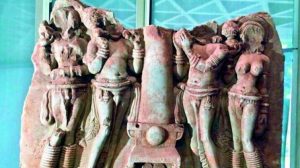
17th century, Kathmandu. The Buffalo-faced, multi-headed deity has 34 arms and
16 legs, and marches over birds and other animals. The deity holds his dakini, a
dorje (Tib: vajra) and skull bowl. From Tucci, Rati-lila, The Art and Love of Nepal,
Les Editions Nagel, Paris. 1975. p. 123. Photo by Lorenz Prinz
Familiarity with sexual power as something to honor and utilize for spiritual cultivation is not common, but upon a study of ancient cultures, we see it is nearly universal; and from a review of contemporary yogic practices, we can see it still exists today.
Making sense of tantric Tibetan symbolism that uses copulating deities as part of meditation instruction fits somewhere into that vast timeline of sacred sex. Italian adventurer Giuseppe Tucci was the first Westerner to encounter Tibetan religious art with humility, a connoisseur’s eye for art, and a scientific spirit. He made sense of these coupled deities, describing them as engaged in an “orgiastic dance,” and appreciating them as part of a cosmic understanding of life and death. His brilliance was to notice they were in fact dancing, and not merely engaged in erotic embrace.
Just as meditation practice is personal and private, sexual yoga is more so. Any full self-examination must address sexual and generative energy. The Sahaja tradition of sexual yoga was established by tantric mahasiddhas in Bengal in the 8th and 9th centuries, who sought transcendence beyond good and evil, male and female, sacred and profane. Sahaja means natural, co-emergent. The deity Hevajra, dancing in yab-yum, is favored among tantras of the Sahaja tradition and also among the dominant traditions that practice no sexual yoga.
Sahaja is free of them all. For there is neither desire
(Hevajra Tantra)
nor absence of desire, nor a middle to be obtained.
The practice of ritual sex and its purposeful depiction far outdates the notion and religious usage that is it all merely artistic spiritual metaphor. Routinely, from Japan to Afghanistan, Dunhuang to Kathmandu, when a dance is depicted in Buddhist art—whether for decoration, mystical instruction, or philosophical symbolism—it existed as an actual dance in real life first. The same is usually true for depicted clothing and instruments. Even naked deities dancing perform known dances and postures. It is the stuff of a separate column to discuss these antecedents in dance, suffice it for now to report that the roots sink deep into pre-history.
These depicted dances were not invented by artists; they were real movements of actual practitioners. Is the danced sexual congress the same? Does the inclusion and depiction of sexual union have a precedent in actual life? Analysis of the dance depictions suggests it could. If the erotic coupling is part of a dance, the likelihood of an actual physical precedent is great. An extraordinary set of three tantric temples in Kathmandu are covered with carved figures engaged in sexual yoga, making it clear there were dance elements in a ritual sequence of prescribed movements while engaged in sex.

carving, Jwala Mai Temple, Kathmandu. From Tucci, 1975. Photo by Lorenz Prinz
The remarkable mural images from the ruins of Tsaparang, where Tucci surveyed the artistic representations, have become for many the highest known expression of one style of Tibetan art. It is critical to remember that this art was often created by and always intended for tantric initiates. According to tradition and practice, anyone not initiated into these meditation cycles has no psychic access to the content, regardless of however long one might study the images. These dancing deities are designed to be understood fully by none other than initiates. Tsaparang was an important temple, so the nature of the scenes depicted, which are in fact tantra cycles of connected meditation deities and practices, is of a heightened stature. There is no question as to the exalted meaning of the dancing coupled deities.
Tucci suggests after careful examination that the male deities are dancing and the female deities are “holding on.” There are three primary ways in Tibetan art in which deities are erotically conjoined while dancing: the dakini has both her legs wrapped around the waist of the male deity; the dakinihas both legs standing on top of the deity’s standing feet; the dakini has one leg extended, matching the deity, and the other wrapped around the waist of the deity. There are variations of course, including those with multiple arms and legs.

Exterior wall, Sri Senpaga Vinayagar Temple, Singapore. 20th century.
From Core of Culture
The Tsaparang images in sculpture and painting are detailed depictions of dancing. They are not posing. They show positions having one foot supporting the body and the other, usually extended, with the sole exposed, meaning no weight is on the foot. They are dancing, which is to say, moving from one form to another. The weight favors one leg over another, freeing the other leg to execute some step. The dakini facing upward, directly to the sky, with her front arm extended, is a dance position. The lunging deity glares straight outward, supporting the dakini on his hips with one arm.

From Tucci, Indo-Tibetica III-2, plate 66. 1935
One reason that still art, like sculpture and painting, uses dancing positions, is to reveal the deity in their full power; frozen in time, the deity performing a precarious athletic movement signifying spiritual accomplishments. This is depicted dance, reflecting visionary dance in meditation. Actual dance becomes key to analyzing living resonances.

revealing the energy and nature of the deities. Demchog Temple, Tsaparang, 2008. From Core of Culture
Going far back into the Indian archeological record, sequential deities with multiple arms and legs have been found to be both a symbol of many attributes and, at the same time, the sculptural equivalent of a time-lapsed photo series: showing more than one dance position, indeed showing a rhythmic sequence of movements. The tantric deity Hevajra is characterized by dancing. At such times as when the meditating monk lifts an outer cover of the hanging painting of Hevajra, under which, above the flickering light of a candle, the figure appears literally to be dancing. Tucci suggests that simply moving the eyes over a scene, with the proper mystical evocation, generates animated dance. Both of these techniques appear among the earliest known art of man, the cave paintings of prehistoric Europe.

goddesses. Painting, Tibet, 19th century. The many arms symbolize the deity’s
attributes as well as pure energy and the moving shapes of a dance. Above a
flickering candle, the pictorial image appears to dance. Evoked by meditation
techniques, the visualized image begins and continues dancing.
Image courtesy of Sotheby’s

Trois Freres cave, France. This image is isolated here from a huge
and complex cave surface painting. Initiates under the influence of
hallucinogens were brought into fire-lit caverns. The entire surface of
the cave wall danced, as the initiates did too. From Four Hundred
Centuries of Cave Art by Abbe Breuil, 1952, p.164-165, Centre
D’etudes et de Documentation Prehistoriques, Montignac
If they are dancing, obviously they are doing more than just having sex. What kind of dance is this? Dance is used in many artistic traditions as a symbol of skill and divinity. Deities don’t walk; they dance. The great skill required in the sexual yoga of tantric, as well as Taoist, practices is that of the male partner retaining his seed and “re-circulating it,” rather than ejaculating. His dakini continually raises the level of energy fundamentality, and the deity raises the whole consciousness to another plane by his tantric sexual skills and mastery of energy transformation and integration.
Dance is the quintessential symbol of skill. Dancing deities do what mere mortals cannot. That the deity is dancing means the couple sustains the true tantric fullness of energies and exhibits the skill of mastery of forces—a mastery of sexual nature—leading to a transcendence of dualistic apprehension. It is the highest state imaginable, energized at a primal level. Chakrasambhava and Vajrayogini dancing in erotic union is the symbol of yab and yum in their fully energized potential, embraced by a transcendent—not reproductive—unity. That is wildly erotic, pre-existence erotic. At the same time, it is a path to realization.
Guru Rinpoche often appears in art accompanied by his two tantric consorts, Yeshe Tsogyal and Mandarava. Interestingly in regard to Buddhist dance, these three: Guru Rinpoche, Yeshe Tsogyal, and Mandarava, are responsible for transmitting and teaching dances to famous yogis in yogic visions. Many of these dances are still performed. The visionary Buddhist dance tradition is an emanation of the tantric unions of Guru Rinpoche.
Guru Rinpoche famously used dance to subjugate the local deities, and dance keeps them entranced into service to Buddhism as dharmapala. Dance is a tantric form of subjugation, entrancement, and re-consecration of ancient powers. The founding of Samye Monastery, the first Tantric Buddhist monastery in Tibet, was completed thanks to Guru Rinpoche subjugating the ancient local deities by means of a dance. The depicted dance of these coupled deities, with origins in the roots of tantra and indigenous Tibetan practices, is another example of the subjugation and transmutation of elemental powers by Tantric Buddhism. Sex is sex, but dancing sex has to follow the steps. It is a consecration.

From Tucci, Indo-Tibetica lll.2, Reale Accademia d’Italia, 1935. Rome. Plate IV
There are five wrathful Heruka yab-yum images in the tantric cycles painted in the Tsaparang murals about which Tucci writes. While Heruka appears as five versions of himself, he is also a hypostasis of the temple’s main deity, Chakrasamvara, a deity dancing while coupled in erotic embrace. Now, by some quantum tantric formula, Chakrasambhava in yab-yum is exploding into five coupled dancing Herukas! Is that itself a re-circulated moment of release become a blown-out mystical involution?
Actually, the phallus and yoni are not shown in these images. Sometimes the deities’ testicles are seen, but not in the Tsaparang images. There is also a set of terrifying ithyphallic (fully erect) wrathful deities, considered an even more extreme figure for potential transformative energy than the coupled deities; and there are numerous explicit depictions of the yoni in the many dakinis and yoginis. The coupled deities are, in fact, less explicit than other Tantric imagery, yet there is a raw power in them, and the sex act must become an act of the observer’s mind. In this symbol, the sex act is depicted but not shown. In this, the observer—the meditator—controls the evoked and awakened powers.
This three-part look at the deities in yab-yum is an introduction to thinking about these powerful and expressive symbols. The study and writing could go into more depth in every aspect brought forward, whether religious, artistic, or choreological. It could also go in different directions: India, indigenous Tibet, China, Central Asia, Kashmir, Iran. No one culture invented sex. The oldest art in the world includes representations of mother goddesses and the phallus; animals, hunting and dancing. Whatever else these dancing wrathful deities in erotic embrace are, they are a variation on the oldest reason for art.
Orgiastic? The dance of coupled deities is orgiastic inasmuch as raw sexual power is unleashed. The other full complement of the depicted mystical reality is that sexual power can be controlled, become symbolic, ritualized, and used as a path on the Way. Dance provides order and entrancement. The dances are orgiastic as well in depicting the sexual component of an ancient mystery rite. Tucci was wise to point out what our culture has left behind— the spiritual language of the living body.
Related features from BDG
Giuseppe Tucci, an Orgiastic Aha! Part One
Giuseppe Tucci, an Orgiastic Aha! Part Two
An Orgiastic Aha! Epilogue: Tucci in His Own Words












